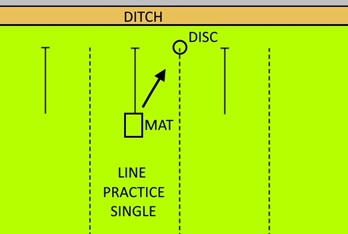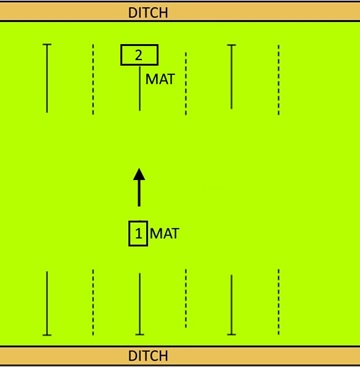Coaching Exercises
Bowling Clinic for coaches run by Lachlan Tighe
These exercises were demonstrated at a bowling clinic for coaches run by Lachlan Tighe, ex Australian Bowls Coach, at the MCC Bowls Club, Hawthorn, in May 2019. The exercises are used by elite coaches and bowlers and are a great way to improve one’s bowling.
I attended 3 sessions, with George Liondas, Bruce Hexter and Kevin O’Connor and have been asked to prepare a summary of these exercises for the use of NBBC members.
In the coaching sessions of Lachlan Tighe, there was a strong emphasis on regular PRACTICE with a PURPOSE in order to improve, and that training should be fun. Enjoy!
Ken James, Member, North Balwyn Bowls Club
Reference:Lachlan Tighe Website
The exercises aim to:
- improve the line of bowling (5 minutes)
- improve the control of length (or weight) of bowls and (10-20 minutes)
- enjoy a fun way of warm-up prior to bowling (5 minutes)
Each exercise is simple and can be done quickly, or incorporated into a regular practice routine. Each exercise can be scored so a bowler can measure how they are bowling.
Exercise 1 – Hitting the Spot (Single Bowler)
This is a line exercise.
Aim – to improve the consistency in line that a bowl is delivered.
Preparation – 4 bowls, a mat, and a disc or coin.
| Description Place mat on the front dot and face back towards the ditch.Place a disc or coin on the adjacent back dot line (near to the ditch).Bowl four (4) bowls over the disc or coin. Score 1 for each time the bowl passes over the disc/coin. |
 |
Score
- score 1 for a BOWL that passes OVER the DISC
- score 0 for a MISS
Target Score – 75% (3 out of 4).
10 Bowl Line Test
10 bowls over the disc gives a measure of consistency in bowling down a line. The number of hits out of ten can be easily converted to a percentage. E.g. 6 out of 10 is 60%.
If you are bowling at 20 to 40%, you can use this exercise as a practice and try to improve. 60% is considered a good score.
View a VIDEO of exercise 1.
Exercise 1a – Hitting the Spot (Pairs)
This is a line exercise.
 |
Two bowlers
Set up mats as shown and each bowler takes turns in bowling over the disc. Competition Good exercise where competitive emotions emerge as one bowler tries to beat the other. |
Exercise 2 – Ditch Mat
This is a line exercise.
Aim – to improve the consistency in LENGTH
Preparation – 4 bowls, 2 mats, (no jack)
| Description
Place MAT 1 on the rink at the MINIMUM DISTANCE. Place a second MAT (sideways) on the BACK DOT. Bowl four (4) bowls over the second MAT on the BACK DOT and stay on the RINK. DO NOT
|
 |
Score
- Score 2 for each BOWL that passes over the MAT and stays on the RINK.
- Score 1 for a BOWL that passes the FRONT of the MAT and stays on the RINK. BOWL does not pass over the mat and can be WIDE (but within the boundary lines)
- Score 0 for a SHORT BOWL. Short is before the FRONT of MAT 2
Target Score – 75% (3 out of 4). If you are bowling at 50% for the LENGH Exercise, you are doing well.
Length Variation
Move the MAT 1 on the RINK back. Repeat the LENGTH Exercise. Hardest is when the MAT 1 is on the back dot and the full length of the green is used.
This LENGTH exercise can be used in practice and is good to take the focus away from the jack so you concentrate on LENGTH.
What you Learn
This LENGTH exercise encourages bowling AT the jack. It is excellent practice to learn how to keep the bowl up and NOT be SHORT. It is also excellent practice for a gentle UP SHOT that stays on the rink and does not go into the DITCH.
Exercise 3 – The Caterpillar
This is a warm up exercise.
Aim – to deliver 4 bowls to the one length in a group
Preparation – 4 bowls, 1 mat, (no jack)
Description
|
Target – 4 bowls together make a CATERPILLAR
|
| Length Variation
Move the MAT from back dot to change the length. Repeat the CATERPILLAR Exercise. What you learn This CATERPILLAR exercise helps in LENGTH control and to REPEAT good bowling practice. After doing this for 2 or 3 ends you will have a better understanding of what is required to vary your length, and to repeat a good bowl. This exercise is also good to identify causes of a bad bowl, such as a variation in your delivery. Work on the good delivery and try to be consistent. |
|
Practice Routines
Practice routines lead to better bowling grass & length/weight control. Always start your training session with ‘4 up and back’
Grass/Delivery Line
Remove the jack from the green and place the mat on the Tee and try to draw to the centre line, on both hands.
Your aim is to draw 4 bowls to within 1 mat length (or 1 mat width if that’s too easy) of the centre line.
If you don’t succeed on the first two ends then keep going till you do. There is no set length, the only objective is to draw to that centre line.
When you succeed, then move the mat up 2 metre, a compliment, and repeat. If you fail then move the mat back 2 metre, reinforcing that you did not succeed.
There is no point in doing anything else until you find the correct draw line. Soon you will be able to find the centre line very quickly.
While you are finding the centre line you are also getting a feel for the pace of the green and again, without thinking about weight, you are are able to adjust naturally to different greens. At NBBC we have 3 greens of different speed, so you can move from one green to the other for varying speeds.
Length/Weight Control
Once the draw line is established, the next job is to draw with consistent weight. Once again there is no jack or no specific length in this exercise.
With the mat on Tee again, draw four bowls on one hand, trying to group them as closely together as possible. Like a caterpillar. Say use a metre, if too easy then a mat length as the distance your bowls finish within.
You should try different lengths and different hands until you can consistently draw all four bowls close together. A variation is to again move the mat up 2 metre when you succeed or back 2 metre if you don’t caterpillar.
You can then start to move the mat up the line and as long as you keep the same angle on the mat you will find that you will always finish on or near the centre line.
Concentration and consistency are the main ingredients to this little warm up and the more you start with this exercise the less time you will need to establish the basics of line and length.
Take your time to ensure you are doing the same thing every time you step on the bowling mat, i.e. a consistent delivery. Make sure you are balanced with the non bowling hand on your thigh and above your knee. A 3 legged stool is more stable than a 2 legged stool. Don’t be like a bird fluttering with the left hand a wing.
If it’s not working, see a coach to check you are making the same movements every time – most people start adjusting line or weight when things go awry when it is normally a variation in the delivery technique
that is the problem.
In the rollup before pennant, pay particular attention to your line and weight so that adjustments can be made right from the first end.
Other Coaching Exercises
Here are other coaching exercises that can assist you in becoming a better bowler.
1. Delivery Line
Set up 2 CD’s/markers/cotton wool, 3 to 4 metres at 20cm apart on the approximate F/H delivery line. Play 4 bowls between these. Adjust CD’s for your bowl to finish on or close to the centre line. Play back similarly on the B/H. You must deliver from the same foot position on the mat for each 4 bowls.
2. Caterpillar/Consistency
Use 4 bowls backhand. Aim is to rest on previous bowl, i.e. consistency. Play first bowl, to finish within rink say near centerline, second to rest on 1st, 3rd to rest on 2nd and 4th to rest on 3rd bowl. No jack needed, but can use a marker if required. Score 2 pts for resting or within 15cm of previous bowl and 1 pt if within 1 ML of your previous bowl. Repeat using forehand. Four ends of this exercise is a very good warm up exercise.
3. Obtaining Rhythm
Place mat at end of front dot, ~6M from ditch, bowl to the ditch to obtain your rhythm, play at your weight.
4. Drawing to Mats
Aim is to consistently achieve line and length. Using 2 mats, place on centre line. A – Delivery mat on back dot, Receiving mat at 22M. Play 4 bowls to finish on the mat. B – Changeover using mat at 22M as Delivery mat and mat on back dot as Receiving mat. C – Vary mat position to back dot to back dot. D – Also front dot to front dot, and other positions, but concentrating on line and length/weight.
5. Drawing to Ditch
Place mat at end of front dot, jack 1 metre from ditch, in centre, play to finish at least between the 2 metre mark and ditch. Vary mat position between 21 metre, front dot and back dot, concentrating on the dots.
6. Jack in the Ditch
Jack in the ditch, use jack marker on the bank, shot bowl is 1 metre from ditch in front, play to finish between shot bowl and ditch. Score 3 points for obtaining shot, 1 point between ditch and 1 metre but not shot. To make the exercise more difficult, place the shot bowl a mat length in front of jack.
7. Jack Off Centre
Jack 2M from ditch between centre line and boundary, draw within your effectiveness zone, i.e. mat length or 1metre. Mat position can be varied, preferably starting either short or long and moving the mat say 2metre when you succeed, i.e. positive reinforcement. This will assist when the jack is moved off centre and also bowling to a position. Also it will remove the fear of finishing in the ditch.
8. Jack Near Ditch
Jack 1M from ditch, on centre line or either side, draw within 1ML or 1M of jack. Additional information in No7 also applies.
9. Conversion Shot
Set up Jack/CD 1 metre in front of T, mat 23 metre from target, also 2 Bowls or Flapjacks or markers are placed 15cm either side of jack. Play 2 bowls F/H and 2 B/H, ‘yard on’ through the jack/CD. Bowls are not to finish in the ditch, i.e. the bowls must stay in play. When satisfied with this distance, move the mat to ~27M, then ~31M, back dot. Target may also be varied from the T for 3M to 5M on shots. Always making sure that your bowl stays in play. Bowl in the ditch shows you have played too much weight. This tests the ability to play conversion shots (Half metre on, Yard On, Trail, Wrest) with the bowl staying in play. A successful conversion shot is devastating to your opponents, so master this shot. If desired, score 5points for hitting the jack, 3pts for either bowl or -1pt for missing, for feedback. Play over 4 ends for each test.
10. Firm Shot
Set up Jack/CD 3 metre in front of T, mat 23 metre from target, also 2 Bowls or Flapjacks or markers are placed 15cm either side of jack. Play 2 bowls F/H and 2 B/H, firm through the jack/CD, i.e. 3 -4metre thru. Bowls are not to finish in the ditch, i.e. the bowls must stay in play. When satisfied with this distance, move the mat to ~27M, then to back dot. Always making sure that your bowl stays in play. Bowl in the ditch shows you have played too much weight. This tests the ability to play firm, with the bowl staying in play. A successful firm shot is devastating to your opponents, so master this shot also. Angles of the green, 4metreson requires ~4/8ths less green than a draw. If desired, score 5points for hitting the jack, 3pts for either bowl or -1pt for missing, for feedback. Play over 4 ends for each test. Instead of a jack/marker, a mat or table mat (~30cm x 45cm) or a micro fibre cloth can be used as a target.
11. Get Second Shot
Place a bowl 2/3rds metre from jack, any position, bowl your other 3 bowls to be closer. Mostly a bowl closer than this will be second shot or even shot. Don’t leave it to Skip to obtain 2nd shot. In a game, don’t niggle (unless Skip has requested this), draw to get second shot.
12. Draw Around Short Bowls
Set up Jack/CD on T, a bowl/marker 1metre in front and ½ metre from centre line, both sides, mat ~23 metre from T Play 2 bowls F/H and 2 B/H, around short bowls, aim to finish within 1metre, preferably 60cm. When satisfied, move the mat to ~27M, then to back dot. Make sure your bowl stays in play. This tests your ability to ignore short bowls. Instead of a bowl, use a marker or mat for the short bowl, is not disturbed. This may be set up both ends for a more intensive practice.
13. Obtaining Your Delivery Rhythm
Place the mat approx. 6 metre from the ditch, on the front dot at North Balwyn, and play towards the ditch, either along the line or at your normal delivery angle. This exercise enables you to obtain your rhythm and saves walking to the other end to collect your bowls. The mat maybe moved to 10metre or any desired distance. If you place the mat at an angle similar to normal delivery, then you are able to see if your delivery is along your delivery line. During a game there is nothing to stop you practising your delivery rhythm as long as you do not interfere with the player on the mat.
14. Drawing to a Square
Place 4 CDs, 1.5metre square, centre line thru the centre, mat at 21metre. Play 4 bowls preferably same hand, say forehand, this is practice. When satisfied or 4 bowls finish within the square, move the mat to 23metre and repeat. Subsequently increase the mat distance by 2metre. By making a similar square in the opposite direction, mat at 21metre, play backhand, you will save time and increase your training effort. If 1.5metre square is too easy, reduce the square to 1metre. This square or CDs or a configuration to represent a ‘bowls head’ can be used as a target for other shots e.g. ‘metre on’, firm, drive, etc. Shots. Remember start your session with a caterpillar to obtain your rhythm and assess the green conditions. Also check the BV magazine ‘The Shot’ for Coaching or Practice column.
15. Competition for Pairs or Triples – Last Bowler Standing
Aim – develop a consistent bowls pattern and less wayward bowls.
- Using 4 bowls each (or 3 bowls each for a shorter game). Toss, winner rolls jack, jack not centred, left where it finishes, but not in the ditch.
- If the jack rolled is short or dead, one of that bowler’s bowls is removed from play and the next bowler rolls the jack. Similar conditions apply to this bowler.
- Play all bowls in turn.
- When all live bowls have been played, remove the bowl furthest from the jack and any dead bowls.
- Bowler with the closest bowl to the jack rolls the jack for the next end, play in turn.
- Play continues until one bowler is left with bowl/s to play. Winner of the game is the only bowler with one or more bowls still to play.
- Jack may be moved. If a bowler moves the jack out of bounds, then they lose a bowl and jack is placed as close to original position as possible.
- If desired, add your own variations.
16. Yard on Shot
- Set up 2 CD’s on the T about 30cm apart, with two others 1metre behind (towards the ditch) and 30 to 40cm away from the centre line continuation, i.e. ~7/8ths of your draw shot aiming line.
- Mat say 25metre away, play Forehand and/or Backhand to pass thru the CD’s and finish close to the CD between the T and ditch.
- Move the mat back in 2metre steps, when satisfied.
- This shot can be used to trail a jack, take out a shot bowl, promote a short bowl, for a plant etc.
- It is an extension of a draw used to strengthen and alter heads in a positive manner.
- If you play too heavy, your bowl will end in the ditch, >2metre on.
- This exercise can also be played with the mat ~2metre from the delivery T, and the target CD’s at ~25metre.


